Lublin Triangle
The Lublin Triangle is an economic, cultural and political format of three European countries – Lithuania, Poland, and Ukraine for the purposes of strengthening military, cultural and economic cooperation with one another along with supporting Ukraine's integration in the EU. The countries of the Lublin Triangle have declared their support to the restoration of Ukraine's territorial integrity within internationally recognized borders and call for an end to the Russian aggression against Ukraine. The Lublin Triangle supports granting Ukraine the status of NATO enhanced partner and state that granting Ukraine a NATO Membership Action Plan is the next necessary step in this direction.[1][2][3]
Lublin Triangle (LT, TL, ЛТ) | |
|---|---|
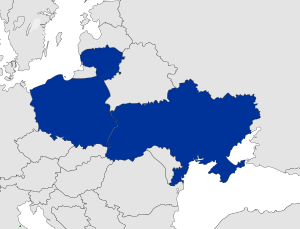 Lublin Triangle countries | |
| Membership | |
| Establishment | 28 July 2020 |
| Area | |
• Total | 981,607 km2 (379,001 sq mi) |
| Population | |
• 2020 estimate | |
• Density | 81/km2 (209.8/sq mi) |
| GDP (PPP) | 2019 estimate |
• Total | |
• Per capita | |
| GDP (nominal) | 2019 estimate |
• Total | |
• Per capita | |
The tripartite format is based on the traditions and historical ties of the three countries. The relevant joint declaration was adopted by the ministers on July 28 in Lublin, Poland. Lublin was chosen as the location as an intentional allusion to the medieval Union of Lublin that created the Polish–Lithuanian Commonwealth, one of the largest countries in Europe at the time.
Initiatives
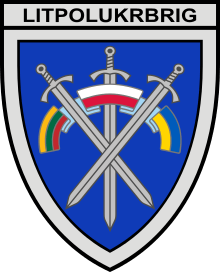
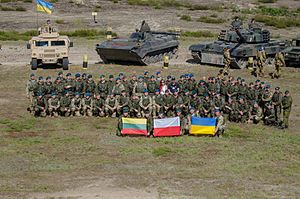
Lithuanian–Polish–Ukrainian Brigade
Lithuanian–Polish–Ukrainian Brigade is a multinational unit with capabilities of a general military brigade, designed for conducting independent military operations in accordance with international law or participating in such actions. It is composed of the three countries’ special military units selected from the 21st Podhale Rifleman Brigade (Poland), the 80th Airborne Assault Brigade (Ukraine), and the Grand Duchess Birute Uhlan Battalion (Lithuania).
Since 2016, LITPOLUKRBRIG has been an important element of NATO actions aimed at implementing NATO standards in Armed Forces of Ukraine. The brigade's main activities include training Ukrainian officers and military units in these standards, planning and conducting operational tasks, and maintaining operational readiness.
Country comparison
| Name | Lithuania | Poland | Ukraine |
|---|---|---|---|
| Official name | Republic of Lithuania (Lietuvos Respublika) | Republic of Poland (Rzeczpospolita Polska) | Ukraine (Україна) |
| Coat of arms | 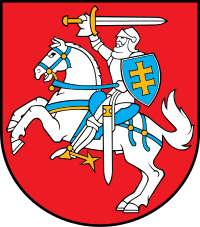 |
 |
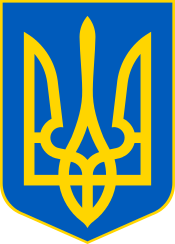 |
| Flag | |||
| Population | |||
| Area | 65,300 km2 (25,200 sq mi) | 312,696 km2 (120,733 sq mi) | 603,628 km2 (233,062 sq mi) |
| Population Density | 43/km2 (111.4/sq mi) | 123/km2 (318.6/sq mi) | 73.8/km2 (191.1/sq mi) |
| Government | Unitary semi-presidential constitutional republic | Unitary semi-presidential constitutional republic | Unitary semi-presidential constitutional republic |
| Capital | |||
| Largest City | |||
| Official language | Lithuanian (de facto and de jure) | Polish (de facto and de jure) | Ukrainian (de facto and de jure) |
| Current Head of Government | Prime Minister Saulius Skvernelis (Independent; 2016–present) | Prime Minister Mateusz Morawiecki (Law and Justice; 2017–present) | Prime Minister Denys Shmyhal (Independent; 2020–present) |
| Current Head of State | President Gitanas Nausėda (Independent; 2019–present) | President Andrzej Duda (Law and Justice; 2015–present) | President Volodymyr Zelenskyy (Servant of the People; 2019–present) |
| Main religions | 77.2% Roman Catholic, 4.1% Eastern Orthodox, 0.8% Old Believers, 0.6% Lutheran, 0.2% Reformed, 0.9% others | 87.58% Roman Catholic, 7.10% Opting out of answer, 1.28% Other faiths, 2.41% Irreligious, 1.63% Not stated | 67.3% Eastern Orthodox, 9.4% Greek Catholic, 0.8% Roman Catholic, 7.7% unspecified Christian, 2.2% Protestant, 0.4% Jewish, 0.1% Buddhist, 11.0% unaffiliated |
| Ethnic groups | 84.2% Lithuanians, 7.1% Poles, 5.8% Russians, 1.2% Belarusians, 0.5% Ukrainians, 1.7% other | 98% Poles, 2% other or undeclared | 77.8% Ukrainians, 17.3% Russians, 0.8% Romanians and Moldovans, 0.6% Belarusians, 0.5% Crimean Tatars, 0.4% Bulgarians, 0.3% Hungarians, 0.3% Poles, 1.7% other |
| GDP (nominal) | |||
| External debt (nominal) | $34.48 billion (2016) – 31.6 % of GDP | $281.812 billion (2019) – 47.5 % of GDP | $47.9 billion (2018) – 46.9 % of GDP |
| GDP (PPP) | |||
| Currency | Euro (€) – EUR | Polish złoty (zł) – PLN | Ukrainian hryvnia (₴) – UAH |
| Human Development Index |
References
- "Kuleba, Czaputowicz and Linkevičius launched the Lublin Triangle - a new format of Ukraine, Poland and Lithuania". 28 July 2020.
- "Joint Declaration of Foreign Ministers of the Republic of Poland, the Republic of Lithuania and Ukraine on establishing Lublin Triangle". 28 July 2020.
- "Meeting of Foreign Ministers of Poland, Lithuania and Ukraine". 28 July 2020.
- "Pradžia – Oficialiosios statistikos portalas". osp.stat.gov.lt.
- demografia.stat.gov.pl/. "Population. Size and structure and vital statistics in Poland by territorial divison. As of December 31, 2019". stat.gov.pl.
- "Population (by estimate) as of June 1, 2020. Average annual populations January-May 2020".